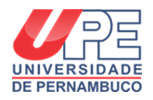Events

Discente: DOURIVAN DIEGO DE MELO PEREIRA
Título: VIABILIDADE DO USO DE MODELOS DE GRANDE ESCALA COMO DESCRITORES DE IMAGEM NA CLASSIFICAÇÃO DE RESÍDUOS SÓLIDOS
Orientador: PROF. DR. CARMELO JOSÉ ALBANEZ BASTOS FILHO
Coorientador: PROFA. DRA. MÁRCIA REJANE OLIVEIRA BARROS CARVALHO MACEDO
Examinador Externo: PROF. DR. CLAUDEMIRO LIMA JÚNIOR
Examinador Interno: PROF. DR. MANOEL HENRIQUE DA NÓBREGA MARINHO
Data: 10 DE DEZEMBRO DE 2025
Horário: 14:00
Local: On-line
Resumo do projeto:
A gestão eficiente de resíduos sólidos urbanos representa um dos maiores desafios para a sustentabilidade nas cidades inteligentes, sendo historicamente limitada pela dependência da triagem manual e pela ineficácia de tecnologias convencionais em lidar com a heterogeneidade e a desordem visual dos materiais. Diante das limitações das Redes Neurais Convolucionais (CNNs) em fornecer descrições contextuais, esta dissertação investiga a viabilidade e o desempenho de Modelos de Linguagem de Grande Escala (LLMs) multimodais como descritores automáticos de imagem para a classificação de resíduos. O objetivo principal foi avaliar a capacidade dessas arquiteturas em gerar descrições semânticas precisas em cenários complexos. A metodologia adotou uma abordagem exploratória e experimental, utilizando um dataset intencional de 10 imagens que representam desafios visuais críticos, como alta sobreposição e homogeneidade em Resíduos Sólidos Urbanos (RSU), Resíduos de Construção e Demolição (RCD) e Resíduos Mistos. Foram avaliados três modelos: Gemini 2.5 Pro, GPT-4o e LLaVA 1.5 7b, submetidos a prompts simples e elaborados. A análise de desempenho baseou-se em uma avaliação a parti de um formulario, utilizando os critérios de Completude e Corretude. Os resultados estatísticos, validados por análise de clustering e árvore de decisão, demonstraram uma hierarquia de desempenho clara. O modelo Gemini 2.5 Pro apresentou a maior robustez operacional, com mediana de completude superior a 4.3, seguido pelo GPT-4o, que exibiu um comportamento conservador. Em contrapartida, o modelo open-source LLaVA 1.5 7b revelou-se inadequado para aplicações críticas devido à inconsistência e à ocorrência de alucinações semânticas graves. Conclui-se que o uso de LLMs como descritores é tecnicamente viável e promissor para a automação da triagem.
Palavras-chave: Inteligência artificial, modelos de larga escala, sustentabilidade.

Discente: EMANOEL SOARES CÂNDIDO SILVA
Título: GESTÃO TÉRMICA DE BATERIAS CILÍNDRICAS LI-ÍON PARA VEÍCULOS ELÉTRICOS COM NANOFLUIDOS E NEPCMS HÍBRIDOS: NOVOS INSIGHTS E MODELAGEM
Orientador: PROF. DR. JORNANDES DIAS DA SILVA
Examinador Externo: PROF. DR. ANTÔNIO MENDES DA SILVA FILHO
Examinador Interno: PROF. DR. DEIVSON CESAR SILVA SALES
Data: 05 DE DEZEMBRO DE 2025
Horário: 14:30
Local: On-line
Resumo do projeto:
O modelo matemático desenvolvido neste estudo integra três modelos acoplados para fornecer uma simulação abrangente do comportamento térmico de baterias de íons de lítio. Esses modelos incluem um modelo térmico de bateria de íons de lítio, um modelo térmico NeCPCM e um modelo híbrido de transferência de calor de nanofluido. Sua integração permite a previsão precisa de distribuições de temperatura, mitigação eficaz de pontos quentes e gerenciamento térmico otimizado, melhorando assim o desempenho da bateria e a segurança operacional. O modelo térmico da bateria de íons de lítio, o modelo térmico NeCPCM (RT-42 + CuO/Al2O3) e o modelo híbrido (CuO-Fe/H2O) de transferência de calor de nanofluido são formulados usando uma geometria cilíndrica bidimensional (radial-axial) para prever com precisão o comportamento térmico acoplado e a dinâmica de transferência de calor dentro do sistema de bateria. A bateria de íons de lítio exibe uma distribuição de temperatura progressivamente mais uniforme com o aumento do tempo de resfriamento, indicando maior dissipação de calor e redução de pontos quentes localizados. Os resultados quantitativos mostram que as temperaturas diminuíram de aproximadamente 38,24°C a 900s para 35,24°C a 3600s, demonstrando que a exposição prolongada ao canal de resfriamento helicoidal remove eficientemente o calor do núcleo da bateria, levando à melhoria da uniformidade térmica e do desempenho geral da bateria. O módulo NeCPCM equipado com um canal de resfriamento helicoidal demonstra uniformidade de temperatura significativamente melhorada, caracterizada por dissipação de calor aprimorada e mitigação eficaz de pontos de calor. A configuração helicoidal direciona o refrigerante ao longo de uma trajetória espiral, maximizando assim o contato com a superfície, intensificando a transferência de calor por convecção e minimizando os gradientes térmicos em todo o módulo. A análise quantitativa revela uma redução progressiva da temperatura, diminuindo de aproximadamente 41,17 °C a 900 s para 36,52 °C a 3600 s, indicando remoção de calor cada vez mais eficiente e distribuição térmica uniforme ao longo do tempo. Essas melhorias na regulação térmica não apenas otimizam o desempenho de resfriamento do módulo, mas também contribuem para maior confiabilidade da bateria, segurança operacional e maior vida útil do ciclo.
Palavras-chave: Análise térmica; carregamento; descarregamento; armazenamento de energia.

Discente: MARIA BIANCA SOARES PIRES
Título: PRODUÇÃO DE BIOGÁS A PARTIR DE RESÍDUOS SÓLIDOS URBANOS PARA USO NA REFORMA SECA DO METANO
Orientador: PROF. DR. SÉRGIO PERES RAMOS DA SILVA
Coorientador: PROF. DR. DEIVSON CESAR SILVA SALES
Examinador Externo: PROFA. DRA. FABIOLA CORREIA DE CARVALHO
Examinador Interno: PROF. DR. JORNANDES DIAS DA SILVA
Data: 26 DE NOVEMBRO DE 2025
Horário: 09:00
Local: On-line
Resumo do projeto:
Este projeto investiga a viabilidade da produção de biogás a partir de resíduos sólidos urbanos como alternativa energética sustentável. O foco está na aplicação do biogás na reforma seca do metano, visando otimizar a geração de gás de síntese para uso industrial e energético. A pesquisa envolve caracterização dos resíduos, análise da eficiência do processo de digestão anaeróbia, e avaliação dos parâmetros físico-químicos do biogás gerado. A proposta contribui para o desenvolvimento de sistemas energéticos limpos e para a gestão inteligente de A crescente demanda por fontes renováveis de energia e a necessidade de mitigar os impactos ambientais decorrentes do uso de combustíveis fósseis motivaram o desenvolvimento deste estudo, que avalia o aproveitamento de resíduos agroindustriais e domésticos como cascas de abacaxi, mandioca, batata inglesa e resíduos orgânicos diversos para produção de biogás por meio da digestão anaeróbia, com posterior aplicação na reforma seca do metano. As etapas da pesquisa envolveram a coleta e o pré-tratamento das biomassas, seguidos da caracterização físico-química realizada no Laboratório de Combustíveis e Energia da Universidade de Pernambuco (POLICOM-UPE), contemplando análises de umidade, termogravimetria (TGA), composição elementar, poder calorífico, densidade aparente, sólidos totais e pH. As amostras foram submetidas à digestão anaeróbia em reatores de bancada operando em condições mesofílicas (35 °C), utilizando esterco bovino como inoculante para otimizar a produção de metano. Os resultados indicaram maior eficiência nas amostras inoculadas, com destaque para os resíduos orgânicos domésticos. Na etapa seguinte, o biogás foi reformulado por meio de simulações computacionais realizadas no SENAI-RN, utilizando o software Aspen HYSYS. A modelagem contemplou o processo de reforma seca, convertendo o biogás em gás de síntese (syngas) composto por H2 e CO, e simulou etapas como purificação, aquecimento até 800 °C, reforma catalítica com conversão de 71% do CH4, compressão com razão de 2 e ajuste das condições operacionais para a síntese de Fischer–Tropsch (280 °C e 20 bar). A simulação permitiu identificar os parâmetros ideais para maximizar a produção de syngas com elevada pureza. O gás de síntese obtido demonstrou viabilidade como matéria-prima para combustíveis líquidos sintéticos, especialmente o SAF (Sustainable Aviation Fuel), configurando-se como alternativa promissora para a descarbonização do setor aéreo e o reaproveitamento de resíduos. Conclui-se que os resíduos analisados apresentam elevado potencial energético e podem ser integrados a cadeias produtivas sustentáveis. A abordagem adotada comprova a viabilidade técnica e ambiental do processo, reforçando o papel da bioeconomia e da inovação na transição energética brasileira.
Palavras-chave: Biomassa; Biogás; Gás de síntese; Fischer-Tropsch; Combustíveis sustentáveis.


